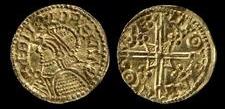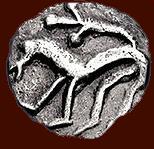








Designed by Nigel G Wilcox






The Paragon Of Metal Detecting
& Archaeology
& Archaeology
Powered By Sispro1
Anglo-Saxon & Viking A.D. - Currency Numismatics,
Mancus
For Reference ONLY
Everything For The Detectorist
Copyright All Rights Reserved by Nigel G Wilcox E-Mail: ngwilcox100@gmail.com
Viking Menu
Viking Timeline
Anglo-Saxon Timeline
| 1. Estimated value 2014 : |
1.
AEthelred II 978-1013 AD

Minted in Lewes, southern England - Minted by the moneyer Leofwine.
Of the few Anglo-Saxon gold coins that have survived from the eighth to the eleventh century, almost all are silver pennies. We do not know whether this is because gold coins were always rare, or because people were more careful not to lose them, as they were extremely valuable. Because there are so few, it is difficult to know what they were used for. It has been suggested that they were religious offering pieces, and not part of the regular currency at all.
Anglo-Saxon records occasionally mention a unit of gold called a mancus. This was probably originally a weight, and it became used as a unit of account worth thirty pennies. It is possible that the mancus was also the name of the gold coin. This example is from the reign of Ethelred II, king of the English from 978 to 1013. It comes from the mint of Lewes, and was produced by the moneyer Leofwine, from the same dies that he used to strike silver pennies. This suggests that it was part of the same currency system. The condition of the coin's surface shows that the dies were already rusty when the coin was produced. This also suggests a currency coin, since more care would probably be taken with a presentation or offering piece.
Of the few Anglo-Saxon gold coins that have survived from the eighth to the eleventh century, almost all are silver pennies. We do not know whether this is because gold coins were always rare, or because people were more careful not to lose them, as they were extremely valuable. Because there are so few, it is difficult to know what they were used for. It has been suggested that they were religious offering pieces, and not part of the regular currency at all.
Anglo-Saxon records occasionally mention a unit of gold called a mancus. This was probably originally a weight, and it became used as a unit of account worth thirty pennies. It is possible that the mancus was also the name of the gold coin. This example is from the reign of Ethelred II, king of the English from 978 to 1013. It comes from the mint of Lewes, and was produced by the moneyer Leofwine, from the same dies that he used to strike silver pennies. This suggests that it was part of the same currency system. The condition of the coin's surface shows that the dies were already rusty when the coin was produced. This also suggests a currency coin, since more care would probably be taken with a presentation or offering piece.
Mancus
Pages
Main Coin Menu
Anglo-Saxon
Menu
Menu
Member NCMD
A.S. Menu
Information Data
























